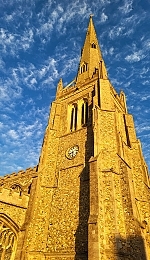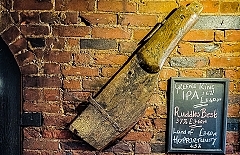Adam Yamey's Blog: YAMEY, page 119
July 22, 2022
Alice through the stained glass windows
CHARLES LUTWIDGE DODGSON (1832-1898), better known as Lewis Carroll, author of “Alice’s Adventures in Wonderland”, was born in the village of Daresbury in Cheshire. During his first few years of life, Charles’s father was the curate of the local church of All Saints.
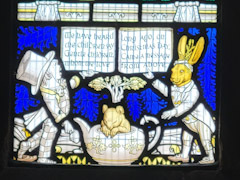
When he was 11, the Dodgson family moved away from Daresbury. Eventually, Charles entered Christ Church College in Oxford. It was here that he met the young child Alice Liddell, daughter of the Dean of Christ Church. It was this young child who inspired Dodgson to create and later publish his famous story. Unlike many other Victorian tales for children it was free from moral instructions.
Dodgson/Carroll died in Guildford, where he was buried. To celebrate the 100th anniversary of his birth, money was raised to create a window in the church in Daresbury to commemorate him. Known as the Lewis Carroll Window, it allows light into a Chapel in the southeast corner of the church. Designed by Geoffrey Webb, it was dedicated in mid 1935.
The stained window incorporates depictions of both Carroll and Alice Liddell, as well as some of the creatures drawn originally by John Tenniel, who illustrated the book about Alice.
A modern addition to the church was built onto its North side. This contains a Lewis Carroll exhibition. One of the exhibits is an old Bell. This used to be attached to a barge that served the religious needs of the people who lived and worked on the canals near Daresbury. This floating chapel was the creation of Lewis Carroll’s father.
We visited Daresbury on a July day when the air temperature was 37 degrees Celsius. Fortunately, it was cooler inside the church. I am grateful to Christine Casson for encouraging us to visit the church with the Wonderland window.
July 21, 2022
Great expectations
I LOVE OUTDOOR sculpture exhibitions. Also, I enjoy visiting the exhibition spaces of the White Cube Gallery, which are located in Piccadilly and Bermondsey. So, it was with high expectations that we drove up to Arley Hall in Cheshire to view an exhibition of outdoor sculpture by artists with whom the White Cube represents.
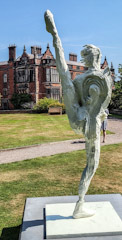
The works on display until the 29th of August 2022 are by artists including amongst others Gormley, Noguchi, Tracey Emin, Mona Hatoum,and Takis. This is a formidable line up of artists.
Arley Hall and its gardens are magnificent. Unfortunately, the same cannot be said of the temporary exhibition of works by eminent modern sculptors. Unlike other outdoor sculpture shows I have seen (e.g. Frieze at Regents Park, Houghton Hall, and the Yorkshire Sculpture Park), what was on display in Arley Hall’s garden was unexciting despite the delightful setting. I felt that White Cube, whose exhibitions are, if nothing else, always dramatic, could have displayed a more impactful selection of artworks.
Exhibition aside,visiting the grounds of Arley Hall was well worthwhile as it has given us the opportunity to spend some time in Cheshire, which we do not know well.
July 20, 2022
The writing on the wall
ALL THAT REMAINS now are the French words ‘moules’, ‘huitres’, and ‘langouste’ (mussels, oysters, crayfish). They are written in large white capital letters attached to a brick wall overlooking Leicester Place, which is a short street running between London’s Leicester Square and Lisle Street.
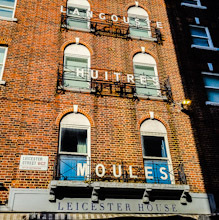
I am glad these words have not been removed,not only because I enjoy consuming shellfish and crustaceans but also because they provide a reminder of an establishment that thrived between the 1950s and 2006, when it closed for ever: Manzi’s restaurant.
Run by an Italian family, the eatery was famous for its seafood. Although I only ate there a few times, it was always an enjoyable experience.
Another restaurant, which has also closed, was on Lisle Street near Manzi’s. It was a Chinese restaurant called Mr Kong. Like Manzi’s, it had seafood on its menu. Their mussels in black bean sauce were superb. Kong’s also had a vegetarian menu – Chinese vegetarian dishes. I am not a lover of veg dishes, but the vegetarian offerings they rustled up at Kong’s were outstandingly tasty.
Usually, I often remember Mr Kong when I visit Chinatown around Gerrard Street, but it was only when I noticed the French words on the wall that memories of Manzi’s came flooding back.
July 19, 2022
The West End is no longer the west end
LONDON’S WEST END includes the part of the city that contains areas such as Chinatown, Theatreland, Covent Garden, Leicester Square, Oxford Street, Mayfair, Soho, Fitrovia, and Bond Street. Before the 19th century, the western boundary of London was Park Lane, which runs along the west edge of the West End.
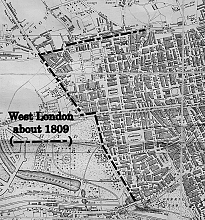 The west edge of London in about 1809: the dashed line that runs from north to south runs along Edgware Road and Park Lane. West of this libe was Hyde Park and open fields
The west edge of London in about 1809: the dashed line that runs from north to south runs along Edgware Road and Park Lane. West of this libe was Hyde Park and open fieldsUntil the end of the 18th century and even during the early years of the 19th, west of Park Lane and the West End was the Middlesex countryside, which was dotted with villages such as (for example) Paddington, Kensington, Chelsea, Hammersmith, Fulham, Acton, Ealing, and Southall. In between these then separated places there were farms, heathlands, parks, stately homes (such as Chiswick House and Osterley Park), and highwaymen.
During the 19th century, several things happened. London expanded in all directions and spread into what had been countryside. The small villages in Middlesex grew in size. Some of them coalesced. Canals and railways were built, and along with them, building in areas that had previously been rural, caused them to become urban. In brief, London spread relentlessly westward. What was called the West End, and is still so-called today, was no longer the west end of the city of London.
Although many previously rustic settlements (such as Paddington and other places mentioned above) became engulfed in the metropolis, most of them have retained at least a few reminders of their pre-urban past. Currently, I am putting the finishing touches on a book about London west of the West End. In it, I hope to help readers discover more about London’s western spread and what has survived it (despite being surrounded by the city’s western expansion).
July 18, 2022
Beneath a church spire
July 17, 2022
An eminent tourist
MANY YEARS AGO, a now deceased Greek friend, ‘S’, related the following story.
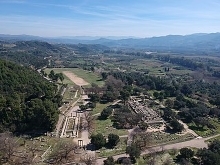 Source: https://commons.wikimedia.org/wiki/File:Olympia_34.jpg
Source: https://commons.wikimedia.org/wiki/File:Olympia_34.jpgS was born in a small port in the Peloponnese long before WW2. It was a place that tourists disembarked from their boats to visit the Ancient Greek archaeological site of Olympia. S left school at an early age (by the age of about 12 to earn money by working on the docks of the small town. When cruise ships called in at the port, he offered services as a tourist guide to earn a few extra Drachmas.
Most of the tourists swallowed the tales that S told them as they wandered around Olympia. However, one day he met his match. An English gentleman accepted his offer to act as his guide. Soon after they reached the site and S had begun giving his customer his ‘spiel’, the Englishman stopped him, saying
“Listen, young man. It is clear that you know nothing about this site and its history. Let me tell you the correct story.”
S listened to his well-informed customer with interest and amazement. It turned out that the knowledgeable gentleman was no other than the future Prime Minister of the UK, Winston Churchill.
Many years later during one of my several visits to Olympia, I was standing in the lobby of a hotel near the site on a warm afternoon. The place was filled with members of an American tourist group. One lady asked her friend if she was going to take a tour around the famous site. The friend replied:
“Aw, no. It’s too damned hot to see more of those old rocks.”
July 16, 2022
Preventing burning in Burnham
MUSEUMS OFTEN CONTAIN interesting surprises for visitors. The small museum in Burnham on Crouch (in Essex) is no exception. It amused me to see that amongst the exhibits there were several early examples of so-called pocket calculators – too large to fit most pockets. I was given one of these (made by Casio) in about 1974, and at the time this was a wonderful gift as well as being a useful tool. I was able to replace my slide-rule with my Casio. These calculators, along with other things that were regarded as being ‘the latest thing’ in the 1960’s and ‘70s, were not what surprised me most at the museum. Hanging on the wall of one side of a staircase, there was a huge piece of cloth with advertisements printed on it. It is part of the fire safety curtain that was used in the local cinema, The Rio (see: https://adam-yamey-writes.com/2021/11/13/a-small-cinematic-survivor/) , in the 1930s.
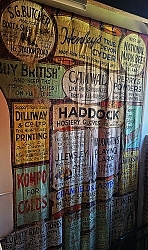
Fire curtains are usually made of metal or heavy materials containing asbestos (or some other fire retardant). They are designed to be lowered (often automatically) should a fire break out on the stage of a theatre or cinema in order to prevent the fire spreading to the auditorium. In 1613, a cannon misfired on the stage of Shakespeare’s Globe Theatre, causing the thatch on the building’s roof to catch fire; the theatre was destroyed. There were no fire curtains in those days.
The first fire curtain (it was made of iron) to be installed in the UK was in 1794 at the Theatre Royal Drury Lane in London. A large fire at the Theatre Royal in Exeter in 1887 led to the wider use fire curtains in British theatres, and later in cinemas. However, these safety devices were not infallible. A fire that began on the stage of the Iroquois Theatre in Chicago (USA) led to the deaths of about 575 people when the fire safety curtain snagged and could not be fully lowered. This led to the invention of an improved automatic fire curtain by John Clancy a year later in 1904.
Fire curtains, which must be lowered at least once during every performance in the UK can be plain or decorated. Plain fire curtains, when lowered, can serve as screens on to which advertisements are projected. The example at the museum in Burnham has advertisements printed or painted on it. Local businesses paid the cinema to have their adverts printed on the curtain that hung in the Rio during the 1930s. The Treasurer of the museum explained that of the many Burnham firms, who placed adverts on the fire curtain, only one of them is still in business. Thus, the old fire curtain (or at least the half of it that is in the museum) not only protected Burnham’s cinemagoers from burning but also serves as a valuable record of the town as it was almost 100 years ago.
July 15, 2022
My father the professor
MY FATHER, BASIL Yamey (1919-2020), lived until he was over 101. Between about 1950 and 1991, he lived in our family home in Hampstead Garden Suburb. From my birth until 1982, I lived there, and afterwards I visited my then widowed father almost every weekend.
 My graduation in 1973
My graduation in 1973Dad was an academic, an economist, at the London School of Economics (‘LSE’). He became a senior professor long before he retired.
Although I have no knowledge of economics even at an elementary level (and this is not me being modest), I lived with an acknowledged leader in the field of microeconomics. Recently, the LSE published some of my memories of living with a professor: my late father. These memories are published on an LSE blog: https://blogs.lse.ac.uk/lsehistory/2022/07/06/at-home-with-basil-yamey-as-recalled-by-his-son/
I hope that you will enjoy these glimpses of the home life of a significant academic.
July 14, 2022
No longer in use
July 13, 2022
Wavy walls and Hercule Poirot
SADLY, THE CHARTERHOUSE was closed to the public when I walked through London’s Charterhouse Square on a Monday in July. As I walked clockwise around the grassy space in the middle of the (not so square) square, I spotted a building with a curvy brick façade with windows, many of which have both curved steel frames and glass panes.
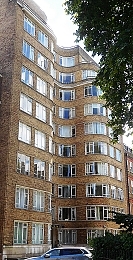
The building, a block of flats which has Art Deco features, is called Florin Court. Although it looks recently built, it was constructed in 1936. It was designed by Guy Morgan (1903-1987) and Partners. Morgan had worked with the better-known architect Edwin Lutyens until 1927. Two years earlier, Morgan and Partners designed another block of Art Deco style flats in Highgate Village: Cholmeley Lodge. Although I was unable to enter Florin Court, I have read (on Wikipedia) that it contains 120 flats; it has a communal library, roof garden as well as a basement swimming pool. The reason that the structure looks so new is that it underwent extensive restoration work in 2013.
Florin Court has a connection with the author Agatha Christie as the following (from https://historicengland.org.uk/listing/the-list/list-entry/1390634?section=official-list-entry) related:
“Best known as ‘Whitehaven Mansions’, its exterior used as the residence of Hercule Poirot in the television adaptations of Agatha Christie’s novels.”
I have never watched this television show, but I am pleased that I stumbled upon this lovely example of Art Deco architecture in the heart of one of the older areas of the City of London.

